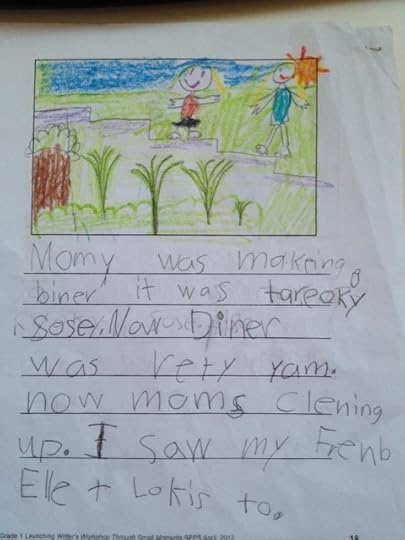Katja Rowell's Blog, page 9
November 28, 2012
“Just go outside and play!” Dubious “obesity” solution and questions of access and empathy.
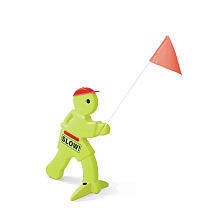 If you recall, our family recently ended our 18 month experiment in rental living. Tired of our peak-of-the-market mortgage and home-maintenance and looming fixes, we sold our home and many of our belongings 18 months ago and moved into a rental situation in an attempt to simplify. The apartment was roomy, had a fitness center, pool, movie room, lovely staff, but didn’t work out for a number of reasons.
If you recall, our family recently ended our 18 month experiment in rental living. Tired of our peak-of-the-market mortgage and home-maintenance and looming fixes, we sold our home and many of our belongings 18 months ago and moved into a rental situation in an attempt to simplify. The apartment was roomy, had a fitness center, pool, movie room, lovely staff, but didn’t work out for a number of reasons.
One of the many gifts from this experiment was the understanding for different living situations. I wrote a little about my observations around the logistics of getting food to a top floor apartment and how the “obesity solution” of “Get thee to a farmer’s market!” assumes so much…
Similarly, the “childhood obesity solution” of telling children to “Just go outside and play” also assumes a blessed privilege.
Which is the reason for this post. Here was how this playing outside business has evolved for us. In our previous home, we lived on a busy street. We could walk or scooter on bumpy sidewalks, and walk in about ten minutes to a great local park. When we moved to the apartmenr, if I wanted M to play outside, I had to drive her to a park and sit there. I would pick her up from school, with a packed snack and water, and drive to a local playground where she could play with her friends. I tried to do this about three times a week for an hour or so. I could do that since:
I work from home
have a husband with the health benefits
I have a car
I have a smart phone so I can keep up with some business needs on the go
At our apartment, there were few options for outdoor play: a small courtyard, where neighbors complained of noise, or the kids in the landscaping. We occasionally resorted to playing Ogo sport in the hall where I had to shush my child. If we played a Wii video game with dancing or jumping, even at 4 in the afternoon, the downstairs neighbors would bang on the ceiling— two floors below.
Contrast then to our new home of 10 days. We now live on a quiet side street in a nice neighborhood. On our first day, while my husband and I unpacked, she played off and on outside for SIX HOURS. I met the parents of the three families where the children bounced back and forth from front lawn to backyard swings. The children are old enough to mind basic safety rules and they played and played. They rode bikes and scooters with helmets (some of them). Another parent had bought those plastic “children at play signs” and placed them on the street. Now and then a parent would check in. We all have cell phones, and when I went out to yell for M in the darkness, hearing shrieks and giggles form the neighbor’s yard, “M!! Time for dinner!” I heard, “Coming MOM!” We walk to school that is four blocks away, we live two blocks from a playground with tennis courts, and soon and outdoor ice-rink. All free for the use. I feel so grateful.
And all the children left at the apartment building (“luxury”rentals) have no playground, and no place to ride bikes…
I’m just saying, many folks could use a little empathy, and a little imagination when handing down edicts to “just play outside.” It isn’t always that easy.
November 20, 2012
Worry Cycle IV: Why Kids Push Back on Pressure with Eating
 This is the last installment for Adoption Month on my introduction to the Worry Cycle. Just in time for Thanksgiving. Maybe at this year’s Holiday table you can experiment and see how it feels if you let the worry and pressure go. It might just surprise you!
This is the last installment for Adoption Month on my introduction to the Worry Cycle. Just in time for Thanksgiving. Maybe at this year’s Holiday table you can experiment and see how it feels if you let the worry and pressure go. It might just surprise you!
Part I reviews why some children present with feeding challenges, and why it is more common for adopted and foster children to experience difficulties.
Part II describes how most parents are simply not well supported or prepared to deal with feeding challenges, and most egregiously, when the very experts they turn to for help give bad advice.
Part III reviews ways that parents try to help children eat well, whether the goal is to get the child to eat more, less or different foods. Here is a summary of the most common culprits I see:
Bribes: “You can have dessert if you eat two bites of chicken.”
Pressure: “You have to eat two bites of everything on your plate,” or “You have to take a “no-thank-you bite.”
Negotiating:“Okay,two bites of this, then one bite of that. No? Three small bites of this one then…”
Catering with cooking: “I made you rice, look! You don’t want rice? Want some buttered noodles instead?”
Guilt: “You are so lucky you got adopted; think of all the children who don’t have this wonderful food,” or “It shows Mommy we love her when we eat the food she makes.”
Begging: “Please, just take at least one bite. Please, please, please.”
Forcing: Physically placing or forcing food into a child’s mouth or holding a child’s head or hands while feeding.
“‘Just make them eat.’—that one gets me every time!”— Sherry, mother of a five-year-old selective eater
Which brings us to the child and Part IV of the worry cycle.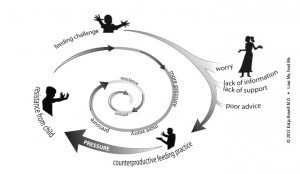 Why kids push back against counterproductive feeding practices, and why all the effort usually makes things worse.
Why kids push back against counterproductive feeding practices, and why all the effort usually makes things worse.
Don’t forget, the good news is you don’t have to work so hard…
When you are locked in conflict over food, predictably strong emotions arise in you and your child. Stress hormones flood his system. Think about when you are upset or stressed. Are you able to tune in and listen to your body? When the child is upset or anxious or waging war at the table, the last thing he can pay attention to is the food. He is locked in battle with you, and the food is forgotten.
When you, the parent, ignore cues coming from your child and try to get him to eat more or less than he wants, that pressure and conflict can compromise his trust in you. As one research paper put it, not feeding in a responsive way “has the potential to undermine the child’s trust in an otherwise responsive parent.” This can hinder the attachment process.
That is why pressure does not help, and in most cases, worsens feeding and growth issues. In essence, parents can unwittingly contribute to the very outcome they are working so hard to avoid. Stress kills the appetite for the anxious child who has been pressured, causing him to eat less. The child who has experienced food insecurity, restriction, or neglectful feeding is prone to overeat in times of stress. Like quicksand, the more you fight and struggle, the more stuck you become.
Stress and mealtime battles make it hard for children to tune in to hunger and fullness cues coming from their own bodies and makes it more likely they will eat more or less than they otherwise would.
Another anxious parent told me: “But we don’t pressure, we praise and encourage. That’s what we were told to do.” Pressure sounds negative, like “push,” “force,” or “threaten.” Many parents don’t pressure in these negative ways, but they still pressure. Praising Bobby for trying a new food can feel like pressure to Bobby. Giving Suzy a sticker or a toy for eating her veggies is pressure. Clapping wildly and commenting about how brave Timmy is to try a food may feel like pressure to Timmy. Going on about the nutritional benefits and how it will make him strong is also pressure. Don’t forget, if you are locked in a power struggle over food and you make a big deal of Bobby eating a piece of broccoli, you have now handed him control. He has a little green power chip.
A little more about “positive” pressure: what kids might think
“Hmm, Mom really cares about me eating broccoli, and I want to annoy Mom.” (You see where this is going.)
The persistent or independent child who wants it to be his idea; he wants to be in control and may feel robbed of that feeling if he is encouraged or praised.
“This stuff must taste really bad if I need a reward to eat it.”
“They must not think I can do this if they are buying me a present.”
“Will they love me if I don’t eat this tomorrow?”
Iris’ A-ha moment
Iris homeschools her two daughters: Ali, her biological daughter, and her youngest, Bea, who is thriving in an open, transracial adoption. Iris notes that with their schoolwork, Ali shuts down completely with any praise or direction, while Bea responds to some direction and is more eager to please adults. When she connected their learning styles to their eating, she says it was eye opening. “I realized we had been subtly trying to get Ali to eat more foods. We knew outright pressure didn’t work, so we tried games, talking up the nutrition, or praising when she tried something. Like with her schoolwork, any attempt to steer Ali toward something backfired. Bea, on the other hand, enjoys food and is more easily encouraged, but that can be a downside, too. She might finish her plate to please an adult rather than listen to her body.” Some kids push back a little, some kids push back a lot, some kids don’t push back at all.
Kids push back because, well, it’s their job. Once they are securely attached, they will need to individuate, or become self-sufficient individuals. Think of the “terrible twos”(your child may be two, or twelve years old…) where the child says “no” to everything from putting on socks to brushing teeth. The struggle is necessary for developing a sense of independence, and if that struggle permeates the feeding relationship, the child’s eating will suffer.
If a child is working on attachment, or has a history of trauma, control feels safe, and power struggles over food allow endless opportunities for seeking control. Often children will seek out conflict, and they will get parents where it hurts most. If eating”healthy” is important to you, they will rebel, if eating less or more is your goal, they may rather fight than eat…
Whatever the reason, pressuring is a lot of effort, causes a lot of turmoil, and research shows it doesn’t work.
Children pressured to eat more tend to eat less, and don’t grow to their potential.
Pressure leads to stress, which kills appetite
Stress makes it harder for a child to tune in to cues from their bodies about hunger and fullness.
Pressure and stress lead children to seek out and rely on safe and comfortable foods.
Children pressured to eat more fruits and vegetables tend to eat fewer.
Unfortunately what generally happens when the child resists or pushes back is that the parent doubles down, tries harder, different tactics or ups the ante. Children may grudgingly give in and a state of simmering hostilities results, or the child may dig in their heals and push back harder Then you have the spiral down to the “black hole” or “dark pit” which is when I usually hear from parents…
My goal is to reach out to parents and professionals at the very beginning of the cycle, to anticipate difficulties and know how to respond in productive ways and avoid endless battles and years of turmoil that harms the child’s eating.
What ways does your child push back? Tears, dramatic refusals, raging for hours, not eating, stealing forbidden foods?
Don’t forget, for every Love Me, Feed Me book sold for November, National Adoption Month, I will donate $1 to the SPOON foundation. There is still time, get that Holiday shopping done early!
Some of the content of this post is adapted from the book…
November 14, 2012
Counterproductive Feeding practices: Part III of the Worry Cycle
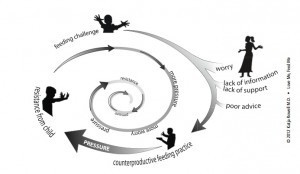 Quick recap of the Worry Cycle so far…
Quick recap of the Worry Cycle so far…
When families find themselves struggling with feeding it usually begins because the child presents with a feeding challenge (anything from an oral-motor delay to painful reflux, to being larger or smaller than average in our current culture). The worried parent, with little support and often poorly advised by the very experts they turn to for help, then turns to counterproductive feeding practices with the goal of either getting the child to eat more, less, or different foods. Which brings us to the bottom part of the worry cycle of feeding: counterproductive feeding practices.
Feeding practices are something doctors, dietitians and feeding therapists need to consider more fully when there are concerns about weight gain, nutrition, or oral-motor issues. (As I mentioned in last week’s post, most docs get no training in this whatsoever.) Yes, rule out medical issues, ask about what the child is being served, but do not neglect the feeding relationship. Remember, according to the WHO,“Inappropriate feeding practices are often a greater determinant of inadequate intakes than the availability of foods in the households.” My goal with today’s post is to assist you in recognizing if unhelpful feeding practices are contributing to your feeding and weight struggles.
We may all be able to recognize that holding a child’s head down and forcing food, screaming at a child to eat, or calling her a “Pig” does not help a child grow up to be a competent eater, but there are many ways that a child can be pressured or fed inappropriately.
What can pressure look like?
Here are a few tactics I’ve seen in my work with parents:
using the TV to get a child to eat more or less
screaming, crying, begging, forcing
leaving the child in the highchair for hours a day hoping he will eat a few more bites
bribing with toys, stickers, money, dessert
playing games, performing “cirque-du-soleil”-worthy tricks if the child takes a bite
excessive guilt-tripping or praising
no-thank you, or two-bite rules*
following the child around with food or supplement drinks and constantly trying to get the child to eat/drink
taking a child to Weight Watchers or making comments about weight, calories, anything to get a child to eat less
focusing on what or how much the child eats (yes, even that can turn some kids off)
“running out” of red-light foods, putting locks on cupboards and fridge
…
I think it is important to acknowledge that pressure seems to work, in the short term, for many parents, which is part of why it is so hard to give it up/climb out of the Worry Cycle. TV may get an extra spoon of rice into your child at that meal, but the pressure or distraction tactics aren’t helping your child learn to be a competent eater and most often makes matters worse. A dad might challenge me at a workshop, “The only way my son ever eats anything green is when I bribe with dessert.” Helping children eat well is a process we can slow down in countless ways, but isn’t really something we can speed up. Children will approach eating skills at their own pace.
If you were pressured, or you’re stuck with feeding now, are there any tactics I’ve missed? Anything you want to add to the discussion? For our final installation on the intro to the Worry Cycle next week, I will discuss why many children resist pressure and push back. Why in essence, all the work and pressure is almost guaranteed to backfire, making feeding struggles worse. The good news is, it doesn’t have to be so hard.
** a teaser for next week’s topic from my book, Love Me, Feed Me:
Two popular pieces of feeding advice: The “no thank you” and “two-bite” rules result in some of the more serious, frequent, and avoidable battles I see. In the first instance, the parent is told to require that the child take one bite before he is allowed to reject a food, or say, “no, thank you.” The “two-bite rule” means the child is required to eat two bites of everything at the table or on his plate.
I often hear variations on this theme, “Our older son is a great eater, and we use the ‘no-thank-you bite’ rule for him. That rule helped him learn to eat with no problems, so we’ve been using it on our younger son, but he’s really picky and we argue over that one bite for most of the meal.” Indeed, the easygoing, eager-to-please, or fearful child may go along with the rules for now, but what happens if you try these methods on the persistent or sensitive child, or the child who is locked with you in a power struggle, or the hurt child who is anxious and desperate for control? These seemingly innocuous rules can result in impressive battles, and are not consistent with the Trust Model. Parents forget that it’s not about one bite—it’s about control.
November 13, 2012
food stash, and helping foster and adopted children adapt to your food culture
My guest post Q and A Part I at Fostering Thrifty Families is up, look for Part II soon. Check it out for lots of practical tips. Also useful if you have a picky or anxious eater—adopted, foster, or biological.
“Too often, the food stash is presented as the solution to hoarding and food anxiety. It seems to have been presented to you as an either/or scenario: food stash, or healthy food on a schedule? I think the answer is both, or no stash, and that it may change with time. One of my main goals is to empower you, to help you know there is no perfect solution or anything that says you have to get it “right” from day one. That’s not how parenting works. We figure it out with each of our kids…”
Remember, that for every Love Me, Feed Me book sold during National Adoption Month (November), I will donate $1 to the SPOON foundation.
November 7, 2012
Why parents get into counterproductive feeding patterns: Worry Cycle Part II
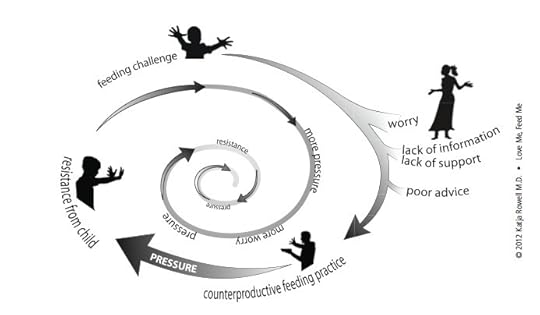 Last week’s post introduced the “Worry Cycle” and why some foster and adopted children present with feeding challenges. The child who is challenging to feed is often the starting point that sets up the difficult feeding relationship.
Last week’s post introduced the “Worry Cycle” and why some foster and adopted children present with feeding challenges. The child who is challenging to feed is often the starting point that sets up the difficult feeding relationship.
This week we move on to the parent dealing with the feeding challenge. Obviously, this is where I want to break the cycle, by offering information and support about best-feeding practices, even in the face of significant challenges…
Poor support
One mom said that “beyond bottle feeding” there was little information out there about how important feeding was for her foster children. Another mother said that beyond being told to give their son a food stash, they had no real guidance about how her adopted son’s history of food scarcity would play out. (See my guest post on food hoarding and integrating a child into a family’s food culture at Fostering Thrifty Families.)
“Despite having read a TON in preparation, I wish I had known how much feeding is a key for attachment, even for older children. I wish I had had more information that there was a good chance that the table could be a very difficult place for a while, and some of the reasons for that—that is, the possibilities of chewing/swallowing/sensory issues. I may have been better able to stay calm and let some things slide if my expectations of a happy family meal had not been met with such a slap in the face.”
Poor advice
From mothers, Mothers-in-law, friends, phone apps, to local news, bad feeding advice abounds:
“Just make him eat it!”
“No kid starved himself, just serve green beans until he eats. ”
“I fed you rice cereal when you were two weeks old, she’ll be fine!”
“Your daughter will be fine, even if she doesn’t eat a thing for three weeks.” (From a pediatrician!)
Perhaps the most vexing and tragic aspect of the work I have been doing with families is that the lack of support and poor advice often comes from the very experts parents turn to for help: doctors are putting food insecure children on diets, speech therapists are force-feeding children or recommending parents withhold attention and love to get a child to eat…*
And here is where I let you in on a dirty little secret. Even though one in three parents will talk to their child’s doctor about a feeding concern, doctors almost universally get no training in assessing or addressing feeding and growth issues. I didn’t. It’s just not in the curriculum. I went to a top ten medical school, and I had no information on feeding issues. I went to a well-respected primary care residency program where I got no training. Yet, I felt I was qualified to give feeding advice. Looking back now, I know I wasn’t trained to do so. The ignorance continues. When I’ve done workshops with pediatrics and FP residents, they still aren’t getting any of this info, even though 80% of children with special needs will struggle with feeding, and an estimated 20% of children are felt to have a “feeding disorder.” I’ve also given workshops to feeding therapists who aren’t aware of feeding research, the Division of Responsibility, or the responsive feeding literature… (Chapter 3 goes into more detail on feeding therapies and finding the right help for your challenges…)
Worry Fuels Counterproductive Feeding
Why does it matter so much that parents aren’t adequately prepared and are given poor advice? Because it fuels the worry, and parents to try to figure it out on their own, or advice leads directly to the counterproductive feeding practice. Parents are already worried and want to do the right thing. When you then have a doctor telling you your child is “obese” or “overeating” and has to be controlled and put on a diet, parents do as they are told, with predictable results. If a pediatrician tells a desperate parent to “do whatever you have to to get food into that child,” is it then a surprise when that parent holds the infant’s head down to get formula in, or screams and threatens the older child to eat? Misunderstandings about growth, feeding research, and how a child’s history plays a role, lead loving and worried parents to pressure with feeding, and that pressure almost never helps…
“My child is too small, my child is too big, my child doesn’t get enough DHA or protein, my child gets too much sugar...” All of these worries lead parents to feed with an goal: to get the child to eat more, or less, or different kinds of foods. This agenda is at the bottom of the pressure and pushing with feeding.
Next we will examine what that pressure looks like. What are counterproductive feeding practices? Sure, we can all agree that holding a child’s head down to eat won’t help, but even sticker charts and praise can turn some children off. Tune in next week.
(Perhaps I should have added the parent’s own issues and history around food at this point. If the parent has a history of an eating disorder or has been yo-yo dieting for years, or himself has a history of food insecurity, trusting this process will be even harder…)
* “Stupid things experts say” series: #1 (random sampling), and #2 (do whatever you have to to get that kid to eat) and #3 (stop breastfeeding your “obese” infant at night) and #4 (douse it in ranch) and #5 (just don’t bring it into the house). Can you add others?
Note, this is a brief introduction to complex feeding challenges. For more detail, read Love Me, Feed Me: An Adoptive Parent’s Guide to Ending the Worry About Weight, Picky Eating, Power Struggles and More. For every book sold for November, National Adoption Month, I will donate $1 to the SPOON Foundation.
November 5, 2012
“But Mom, you said looks don’t matter…”
 Children are smart. They are master negotiators. My husband recently attended a lecture on negotiation, and the instructor used children as the example of the most fearless, ruthless negotiators, with their single-minded focus on the goal. For any of you stuck in the dinner-time “hostage negotiations,” as one workshops attendee put it, you know what I mean. (“OK, so if I have two bites of potato, can I then just have one bite of fish so I can get my dessert?”) But allow me to digress from food and feeding for a moment.
Children are smart. They are master negotiators. My husband recently attended a lecture on negotiation, and the instructor used children as the example of the most fearless, ruthless negotiators, with their single-minded focus on the goal. For any of you stuck in the dinner-time “hostage negotiations,” as one workshops attendee put it, you know what I mean. (“OK, so if I have two bites of potato, can I then just have one bite of fish so I can get my dessert?”) But allow me to digress from food and feeding for a moment.
As a mother of a young girl, I have tried to impart the message that looks aren’t important. As a physician who has treated deadly eating disorders in young women, I strive to instill a positive body image. As a woman in our society, I know how near impossible it is to hang on to that positive self-image, with the onslaught of messages telling us we are never, ever good enough.
In my own home, with my daughter, I’ve let her go with uncombed hair for days, wear the same shirt three days in a row, and even wear uneven goofy ponytails to school picture day, because most of the time I do believe that how she looks is just not important. Beyond getting her teeth brushed twice a day, and tending to basic hygiene, I am choosing to let a lot of the rest slide. Soon enough she will be fretting over her looks, bombarded by our culture where she will be told that how her hair looks, how big her hips or breasts are, or how clear her skin is, is the measure of her worth. I want to push off that day as long as I can. That’s some background…
So, this weekend for my Book Party, a celebration and thank you to the friends and family who supported me as I wrote and published Love Me, Feed Me, I asked M to put on a different shirt, and maybe brush her hair for the special event. (As a child myself on such an occasion, I would have been presented in a lovely black velvet dress with my brushed hair in a clip. And, to be honest, I liked dressing up back then, and occasionally still do. See this stuff is complicated!)
However, to my new shirt request, my M replied, “Mom, I’m comfortable in this shirt, I love this shirt. You always say looks don’t matter, do you not believe that anymore, because I believe it in my heart…” I was about to launch into a speech about making a special effort sometimes, when I just stopped.
Sigh.
Well played little one. You get to wear your crinkly peace-sign hand-me-down shirt and pink leggings. You get to avoid wrangling the knots from your hair, and you are beautiful, and really, really smart. And thank you for reminding me again about what is important and what isn’t.
P.S. We had a great time at the party. M spent thirty minutes getting ready for an event the next day, combing her own hair, requesting poofy ponytails in various places on her head, and wore a dress too. I’m picking my battles, and this battle was one I was happy to lose. Oh, and the photo is of M at the Minnesota State Fair, with “fair hair.” So I’ve also chosen not to fight the plastic pink heels (only for home) or the princess dresses.
How about you? Has mothering and thinking about how your daughter looks surprised you at all?
November 1, 2012
The Worry Cycle of Feeding: Part I for Adoption Month
In honor of Adoption Month (November) I will run four weekly posts on feeding issues related to adoption and fostering. If you have biological children, children who came to you by birth and adoption, or no children at all, I hope you’ll read the series. I’ll introduce the “Worry Cycle” of Feeding, which is applicable to all families struggling with feeding and weight worries…
Part 1 starts with the entry point to what I have called the “Worry Cycle” of Feeding (a title I am not wedded to, but feels right since the worry about feeding, weight etc. fuels the cycle). It’s a visual representation of what I have seen with almost all of my clients to some degree or another, jives with the research I’ve read and the training I’ve had around feeding difficulties. Let me give you a brief tour.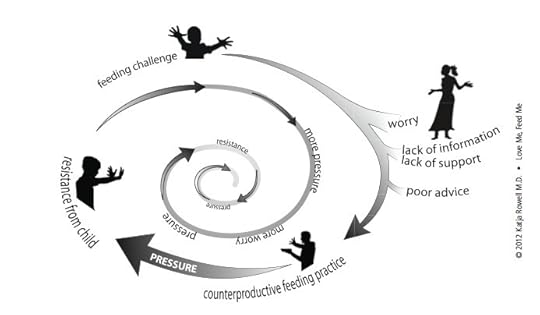
Most children who are having trouble with feeding were more challenging to feed for any number of reasons. This feeding challenge is met by an often bewildered, overwhelmed, under-supported and scared parent who may even get poor advice. This leads to the next phase, of unsupportive or counterproductive feeding practices. Most of those practices are defined by an agenda or goal to get a child to eat more, less, or different kinds of food, which is most often met by resistance or push-back from the child. Then the parent tries harder, or different tactics to control eating and weight, which is met by more and more dramatic resistance.
Alas, most of the clients I work with are deep in the center of the spiral and have been for months to years. Described by parents as the “black hole,” or “bottom of the pit,” it is a difficult place to come back from. Difficult, but not impossible. My goal with this blog, the book, and my workshops is to help families from the start: to anticipate challenges, inform, empower and support parents with best feeding practices so they do not find themselves stuck or circling that black hole. (Ideally my goal is prevention or early support, but the book also offers help and support to families who have been struggling for some time as well.)
So let’s back up and start with the initial feeding challenge which is the focus of today’s post. From Chapter 3 of Love Me, Feed Me:
Where Can Oral- Motor and Sensory Challenges Start?
It might help to think about this complex question this way: oral-motor and developmental/sensory concerns can have a “primary” origin, meaning the child presents with a challenge so that, even in the best environment, feeding may be more difficult. This could include a child born with:
A chromosomal abnormality or genetic syndrome
A neuromuscular condition
Drug or alcohol exposures
An anatomic abnormality such as cleft palate, airway or swallowing tube mal- formations
Heart defects, lung problems, or other major medical conditions that increase calorie needs
Severe reflux, constipation, or other gastrointestinal (GI) issues
Or the problem may emerge because of environmental factors, meaning how the child was cared for, including unsupportive or understimulating caretakers, environment, or feeding.
Within adoption and foster care, many childr en who struggle with feeding have a combination of primary and environmental factors. A child may have been born prematurely or is weak due to low birth weight, poor prenatal growth, heart or lung defect, or in-utero exposures. But what happens after birth also affects feeding and can lead to or worsen sensory and oral-motor issues. Lack of nutrition and poor quality of food can also affect feeding and development if there are deficits of critical nutrients during certain developmental windows…
FYI: The World Health Organization says this about the role of feeding: “Inappropriate feeding practices are often a greater determinant of inadequate intakes than the availability of foods in the households.” I was pleased to see that early feeding is getting more attention and needs to be part of the picture when evaluating feeding difficulties, particularly with adopted and foster children.
….
If you’ve experienced feeding difficulties, can you identify what may have been the entry point, or the reason/s why your child was more challenging to feed? Was there a medical condition, malnutrition, trauma, temperament? Worries about size? Did you think some environmental, or early feeding issues were part of the problem?
What are your initial thoughts about the “Worry Cycle?” Are there other factors you would add?
Next week we will examine parental worry, poor support, poor advice and move into counterproductive feeding practices…
OF NOTE, I WILL DONATE $1 TO THE SPOON FOUNDATION FOR EVERY COPY OF LOVE ME, FEED ME SOLD FOR THE MONTH OF NOVEMBER, ADOPTION MONTH! GET YOUR HOLIDAY SHOPPING DONE EARLY!
October 31, 2012
dinner makes an impression
It seems thankless. That act of day after day, year after year of shopping for and planning and cooking meals, and M got it right— I cook, we eat, then I (though mostly Dad) ‘clens’ up. That sentence exposes the sheer repetitiveness, that can at times get, well, old. And on those days when it gets really old, I give myself permission to get take-out, or make a box of mac-n-cheese, or go out, and then get back at it. But, that repetitiveness is also what makes dinner special. We count on it, we make it a priority, we connect, we eat yummy food. We miss it when we are on vacation or away from home.
I’m sure I wasn’t showering my mother with gratitude at the time, but looking back, family dinners were reliable, mostly “yam” (except her paper thin, leathery pork chops that she baked with a schmear of yellow mustard), and exist in the warm and fuzzy part of my childhood memories. I am hoping that M will look back and feel the same way someday.
I will miss the days of deciphering words… I mentioned on FB a while back how often M refers to meals in conversation and in her “writing moments” activities. See if you can tell what was for dinner that was “yam.”
On another note, to honor national Adoption month, tomorrow I will kick off a 4 part series on feeding challenges, with special attention to the unique issues that foster and adopted children bring to the table. I will also introduce the “Worry Cycle” of feeding, which is relevant to all families struggling with feeding and weight worries. More to come!
P.S. I want to recognize my privilege that I can eat out or get take-out when I get sick of cooking, and that I have a partner who helps with the cleaning up. When my husband is out of town, it definitely feels much, much harder. I tend to serve less family-style for less clean-up, and make less elaborate meals. Just want to acknowledge how much harder it is for families where job hours, or finances make it even more challenging.
October 29, 2012
12 month-old not interested in table foods or feeding himself. Freak out? Not just yet…
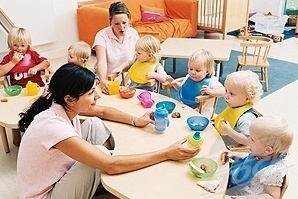 After a workshop for a small corporate daycare center, I got an email from a staff member worried about a little boy in her care:
After a workshop for a small corporate daycare center, I got an email from a staff member worried about a little boy in her care:
…I am concerned about one of the infants at our center. He is almost a year old and has no interest in feeding himself and will only chew and swallow either stage 3 food or food from the food grinder. He also is not oral at all—never puts a toy or anything else in his mouth. He has been a little slow to meet other milestones compared with the other infants, but has met them. I am trying to follow DOR (Division of Responsibility) and not be pushy. He is in the 75th percentile for height and weight so that is not an issue. I just want to be sure I am doing all I can for him while he is in my care. I have had two children of my own and have worked in infant care centers for more than ten years. I am baffled. Usually by now the babies are wanting to feed themselves at meal time, or are at least trying (I usually let them go to town with their meal on their tray mashed and cut up as needed and assist if they are having problems and still sit with them for bottle feeding). Any suggestions?
my reply:
First of all, it sounds like you are doing an amazing job with feeding, not pushing, and providing a variety of appropriate foods. You are tuned in to the children, and they are lucky to have you caring for them.
It’s tough to know if there is or isn’t a problem for this boy. Sounds like you know babies really well, and though he is behind his peers, that may be just fine for him. If his eating and development are both behind and he is making progress that is reassuring. I don’t know if there are any developmental concerns beyond what you are describing as a general delay, but that is something for his parents and doctors to follow and consider.
You could think about getting some textured teething toys, like Tri-Chew, or nubbly spoons (duo-spoon) that he can dip into his foods and handle, or you can dip it and hand it to him, as long as it is enjoyable for you both. These are fine options for the other infants in your care as well. Not getting pushy, even if there is an oral motor delay is critical. What you describe, with him taking and gumming and swallowing purees and stage 3 foods, seems within the normal range of experiences, but it’s good to keep a watchful eye as you are. I have had clients who had a similar experience and the babies did fine, though at their own pace. Others, albeit with more significant delays, had feeding clinic evaluations with one or two visits with some instructions for gentle oral stimulation tasks and saw progress. Still others started feeding clinic therapies where the parents were instructed to perform “desensitization” with brushes and stim toys that the children fought. For these families, therapy tasks and feeding became a battle, which most often slows down progress with learning to eat. That’s not okay.
Whatever road these parents take, they need to follow the child’s lead, continue to expose him to increasingly textured and self-feed foods without pressure. It’s okay if he doesn’t eat anything for a meal or snack here and there. Too often, parents will always fall back on the less challenging, often sweeter pureed foods like the squeezie pouches, if the child rejects or is “too slow” to accept the more challenging foods. Basically, if children are supported well, challenged appropriately with a variety of textures and flavors, are fed with the DOR in a pleasant setting, children most often do their own desensitization. Hope that helps.
About three months later, I got this response:
Just wanted to follow up—without any special intervention, Baby is suddenly eating almost everything in sight! Also have found out through various conversations with the parents that they don’t have family meals together—Dad is picky and both parents are trying to lose weight, so they mostly eat individual-serving frozen meals. Neither cook, and parents prefer stage 3 foods because they are easy. I don’t feel it’s my place to give my input, but the info does offer some insight to the feeding issues the Baby had been having. Dad picks him up and is amazed by all the different foods the little boy has been eating at daycare—the kids actually get a great variety of foods. Thanks again for replying to me on this—helped a ton!
What do you think? Did your little one lag behind her peers, then suddenly catch up? If you experienced concerns with feeding, did your child’s doctor have any tips or ideas that helped, or not? (Chapter 3 in my book Love Me, Feed Me is a primer of sorts on selective eating, oral-motor delays, how feeding issues are often diagnosed and treated, and how to tell if you are getting the right information/support. I let the words of the parents themselves describe their experiences with feeding challenges.)
October 25, 2012
Koala Kupcakes
Sometimes I get tired of being sick and tired. Annoyed with poorly designed studies, bullying, and kids who are put on diets or are forced to eat. So, for something completely different and fun (I do that kind of thing too, though maybe need to more often) I thought I’d share my recent culinary adventures in birthday cupcake decorating! Enjoy!
M is totally obsessed with Koalas. It could be worse. So, there was a koala-themed party. I decided to make koala cupcakes. Here is what I used… Store-bought mix (on sale), store-bought white frosting, a tube of black glittery frosting, left-over pink sprinkles, mini Oreo cookies, a fork, a knife. (I wanted to buy black jelly beans for the nose, but didn’t want to spend $8 on a bag of assorted beans to get 12 black ones… ) I mixed a little black frosting with white and spread it around. Then broke open the Oreos, tossed the half without frosting, Stuck these into the frosting and into part of the cake. Used a fork to schmear on a little white “fur” in the ears, and added a touch of pink sprinkles. Then used the black tube for the facial features. I should have put them in the fridge right away as some of the noses “ran” into the mouth… (I was inspired by a cupcake of a cat that I saw in a magazine that used about 15 different kinds of candy. That’s what makes me a little crazy about many craft or decorating projects, they can pull it off because they have hundreds of dollars of inventory at their disposal!) I’d guess my final bill was under $15. (Including the crazy eyes I tossed. See next photo…)
Here was my first attempt. I think you’ll agree, not cute, and a waste of $3.99 (or so) for candy “eyes.”
Oh, and guess what one of the games was that we played…
Happy Birthday M!I really enjoyed making the cupcakes. I’m a bit of a frustrated crafty, artsy person, so this was a joy.
Alas, M said it was the “worst party” because there were too many kids and it got kind of crazy. My first instinct was to try to convince her it was great! After all, I spent a lot of time trying to make it really special for her. I stopped myself from guilt-tripping her, and agreed it was a little loud and boisterous, told her how sorry I was that she was disappointed and we agreed (10 kids was a lot for my quiet-loving kiddo) we will do things differently next year.
What has your best party idea or inspired cake/cupcake been? Want to share photos on FB??? Head on over! www.facebook.com/thefeedingdoctor

